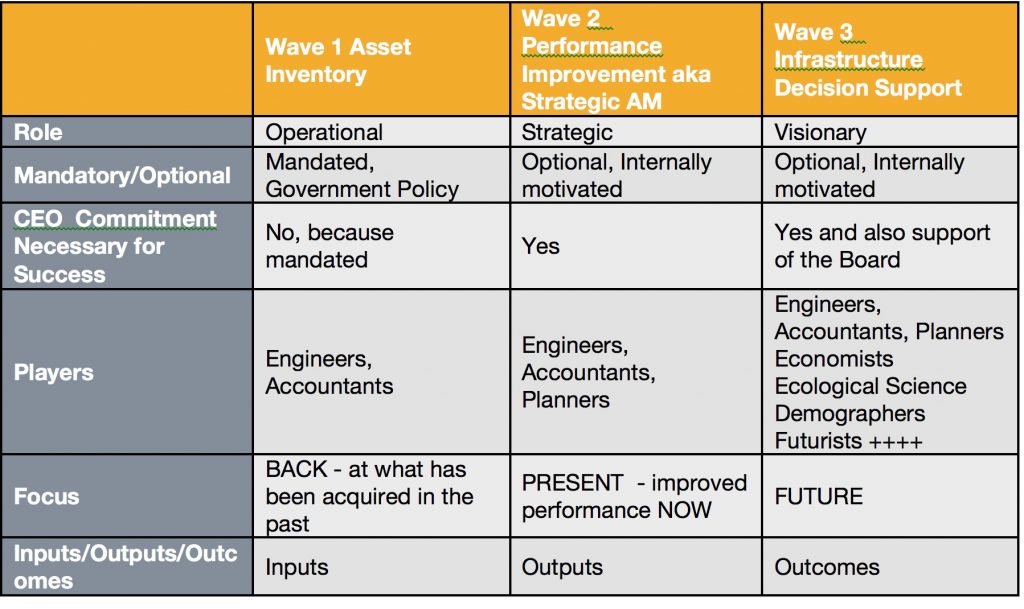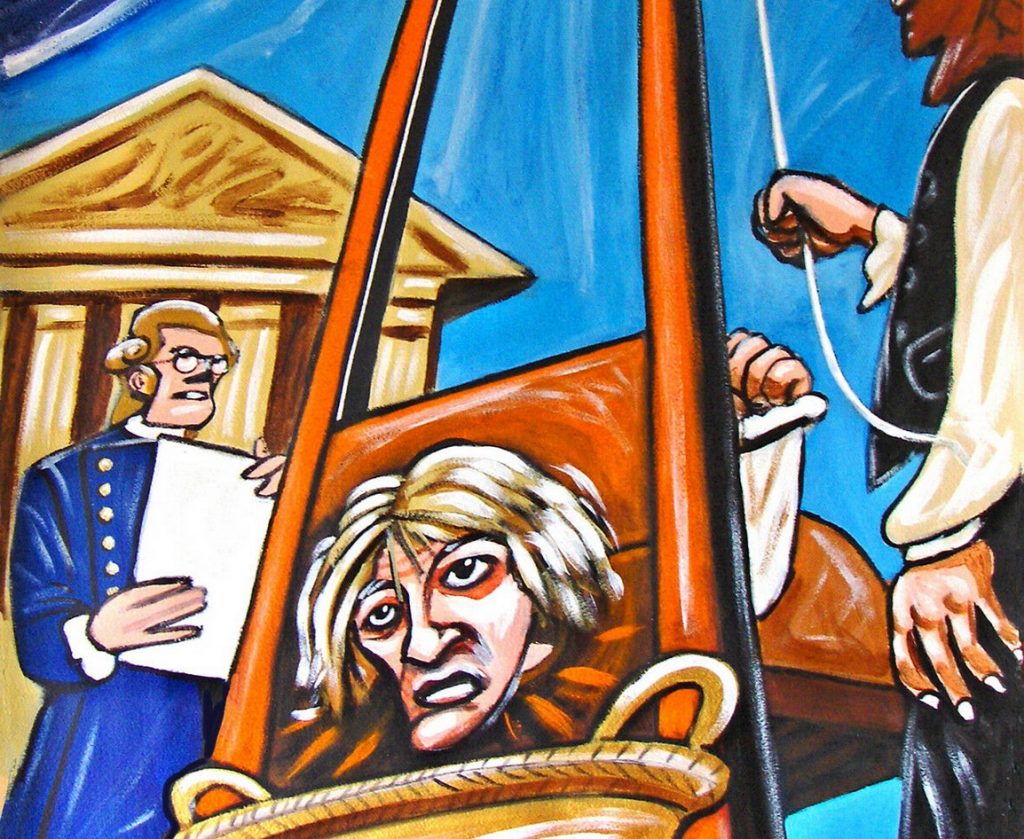
Photo by Marcus Spiske, from unsplash.com
‘I wish it need not have happened in my time,’ said Frodo.
‘So do I,’ said Gandalf, ‘and so do all who live to see such times. But that is not for them to decide. All we have to decide is what to do with the time that is given us.’*
What do envy and the attitudes of some people responsible for infrastructure at this time have in common?
Wishing things were different, instead of getting down and actively working to change things.
This was prompted by a conversation last week with an Asset Manager struggling to get their executive to stop moaning about how unlucky it all is, and start planning for what’s going to be needed going forward from Covid-19. People paid a goodly amount of money to take responsibility, who instead are acting like victims: everything would have been ok, if only….
Wanting the world on your own terms is not a strategy. Managing assets is for life, not just for Christmas, not just the good times.
It made me think again how vital the principle of honesty is for good infrastructure management. Chris Lloyd and Charles Johnson in their Seven Revelations of Asset Management (Assets, May 2014) put it like this: Asset Management demands openness about past performance. We have to face up to what’s gone on before, how well (or how badly) the assets are doing.
But we also have to honestly face up to change – even when it looks calamitous. That is what responsibility means.
Even discussing the deadly sins soon comes round to Asset Management!
The serious point is how we build up that sense of responsibility, in ourselves and in top management, to do our level best with what we have taken on. To commit to be better informed, better trained, to learn from best practice and to live it.
No-one forces anyone else to involve themselves in crucial infrastructure. You do not have to apply to be CEO of a public service, or run for election to the Council – but, having made that choice, it’s not a cushy number.
*J.R.R. Tolkien, The Fellowship of the Ring

In Australia, interest in asset management arose as the result of a series of eight parliamentary reports in South Australia in 1986/1987 modelling the likely cost and timing of renewing all the State’s major infrastructure assets.
The projected costs were so large that they would have absorbed the State’s total capital budget within the next 10 years if urgent action was not taken. To address this problem, the recommendations in the reports covered possible planning and accounting reforms as well as engineering and maintenance changes.
Following the Public Accounts Committee’s Reports, a major SA Government Task Force was established that reviewed, then agreed and reinforced all the ideas presented in the reports. This led to the formation of a Cabinet sub-committee to consider the issues raised, This provided high level impetus for the development of asset management.
Further support was provided by the Auditors-General who were appalled to find that no public sector department. not even the statutory authorities, had decent asset registers and they made this a requirement.
But the most significant change was that led by the Australian Accounting Standards Board. At this time the board covered accounting standards in both the private and the public sectors. The private sector used commercial standards with accrual accounting but the public sector used cash accounting. The board wanted to standardise on accrual accounting for both but was concerned about how this would be received. When it learnt that the Parliamentary Public Accounts Committee in South Australia was promoting the idea of accrual accounting to better understand and deal with infrastructure asset management, it was encouraged to push ahead. Within two years of the release of the final PAC report, the board had released Exposure Draft 50, the model of accrual accounting for local government.
The introduction of accrual accounting meant that local, state and federal government departments were required to move from their previous practice of simply recording annual cash in and cash out, to establishing balance sheets and recording, for the first time, the depreciated value of their infrastructure and other assets,
You might think that an accounting change would be of no interest to maintenance engineers. Fortunately @Roger Byrne was not your ordinary maintenance manager. He had already been in the habit of including economic and planning issues in briefing notes for his clients and he quickly seized on the opportunity this change presented for maintenance engineers.
It was these briefing notes that later provided the content for the first local government asset management manual which subsequently became the IIMM we all use today. So through top down interest and bottom up capacity building, Australia took an early lead in the development of asset management.
The Parliamentary Reports created a lot of interest Australia wide. No other state was prepared, or even able, to duplicate the research for their own constituency but all infrastructure agencies recognised that the conclusions reached applied as much to them as it did to their South Australian counterparts. The CSIRO’s Engineering and Construction division took an active interest, as did State Treasuries and the Auditors-General.
With these organisations, I continued to develop the ideas that had arisen and, after advising governments, commissions of audit, and infrastructure agencies themselves, I created ‘The Asset Management Quarterly’ publication in 1994 to share with others what I was learning. Then, in 1996, noting that lots of interesting things were being done in the name of asset management – but nothing was being documented, I launched the International Asset Management Competitions where the awards went to the best documentation of good asset management practice. They ran between 1996 and 2000 and in 1998 AMQ International launched the world’s first asset management website with information on asset management freely available to all.
The term ‘asset management’ started to become very popular and everyone wanted to get in on the act. One day, flying from Sydney to Canberra my seat companion described herself as an asset manager – on questioning it turned out that she was actually a real estate developer! Once off the plane and into a taxi, on the taxi radio I heard an advertisement for ‘asset management services’ – which turned out to be office cleaning! Yes, asset management had become the buzzword ‘de jour’.
To be continued….
A REQUEST
I am currently working on a book about our beginnings and would love to speak with anyone about their recollections pre 2014.
Please leave your name below and I will contact you.

I woke up with a start last week thinking: good Asset Management is all about time.
We tend to think of managing physical assets being about space – things, in systems and networks, on sites. But this is what we inherit from Engineering. Engineers manage space, things in space. But we do not train them to consider the fourth dimension: what these things in space will look like, or deliver, in ten, or fifty, or a hundred years’ time.
I mean, it is hard enough to design a functioning system: to think beyond individual assets or components, to how they all work together. Our engineering training is not always that successful in getting us to think in systems, and how the whole adds up to something other than all the pieces: to deliver the services our organisations and our communities require. We still have some way to go to this ‘alignment’ from assets to output, let alone outcome. And system interactions can be difficult, especially if they cross discipline and silo boundaries.
But, unfortunately, we have to go even beyond this.
Lou Cripps of RTD Denver describes a good Asset Management practitioner as a time traveller. Managing for the future, based on where we are now, and informed by historical experiences and data. With physical systems, we always have to start where we are now, to be grounded in the physical realities, not floating free in blue skies. And we need the historical experience to be able to project forward, through modelling in its widest sense.
The first engineering manager I worked for described smart engineers as wanting to make leaps unfettered by whatever mess we were currently in. “With one bound, he was free!’ (This also reminds me of some strategic planners I have met…)
A good Asset Manager, I suspect, may be no less ambitious, but focused on something else: the challenge of working from where we are now, whatever that may be, to a sustainable infrastructure future. Not pinning too much hope on magic to come that might change the basic physical realities, or people, but thinking how the next step could lead to the step after that, how one consequence can lead to another, thinking about time and through time.
What kind of tools do we need to assist us in this?
What kind of education do we need for our Asset Managers of the future?

Mama
It was 2016 and I was engaged to train Auditors-General in the Pacific area in how to approach infrastructure performance audits. Their audit offices, like their countries, were not well resourced and they could ill afford to waste time and resources. It was important that they focused on the key issues and got their messages across to decision makers. With my colleague, Kerry McGovern, I spent a week in Port Moresby. At the closing party I was honoured with the title ‘Mama’. I thought this was simply a recognition of my age, but no, “mama” meant a wise woman who leads a village. I was enchanted! Who would not want to be wise and lead a village? And is this not what councils do?
So when approached last week to help the UN who are preparing a manual to assist local governments in under-developed countries struggling to adopt AM, I was happy to oblige. I spoke with Kerry and we prepared out ‘top dozen’, as follows.
What needs to be added?
- Build with your own labour and your own local materials. This will ensure you have the skills and ability to maintain what you build.
- Learn to say ‘No’ when donors offer to build something for you with their labour, or to use imported materials when local alternatives are available. Always seek out alternative practices that use local. Welcome financial assistance if, and only if, it strengthens the ability of your own people in the construction, operation and maintenance of the new assets. That is necessary to ensure that the assets will remain functional.
- Prioritise. Do not accept ‘nice to have’ assets, such as sports stadia or entertainment centres, even as donations, if you have more critical requirements in power, water, roads or communications.
- There is no such thing as a ‘free asset’. Every asset costs you. Not only does it require continuous operational costs such as lighting/heating/cleaning, but it will distract the attention of high level decision makers away from other issues.
- ‘Best practice’ and ‘high tech’ can be deceptive. The real ‘best practice’ is the one that you have the skills and abilities to apply over the longer haul. The same for ‘high tech’. The more complicated the technology the more chances are that something will go wrong and that you will be unable to fix it without outside help. And that help may not be available when needed.
- Give your Auditors-General responsibility for auditing the performance of all public infrastructure for both effectiveness and efficiency – and fund and train them in the ability to do so.
- Be clear on what is to be achieved. Assist the Auditors-General by ensuring that all infrastructure proposals – whether with local or donated funds – state clearly the expected outcomes, in addition to cost and time.
- Identify who is going to operate the asset, who is going to maintain the asset – both scheduled maintenance, and unscheduled maintenance and the costs of enabling the operation and maintenance over the entire life of the asset. Then, with that estimate to hand (and preferably arrived at with input from the people who are going to do it) identify the source of funds to pay for all this.
- If using loan funds to pay for the asset, add interest and redemption payments to the operating and maintenance costs. Ensure you factor in the administrative costs of meeting lender requirements, including the cost of training staff to meet them.
- You may need to train workers to operate and manage the asset. Negotiate with the education department to find out what is involved in ensuring a supply of skilled people, able to operate and maintain the asset and administer loans / grants for the asset.
- Consider how the country is going to set up the support systems to enable the asset to function as intended. For example, if a road, what vehicles will be using the road? where will people obtain these vehicles? how will they be maintained and operated? Who will pay for that? What income streams will cover the costs of the asset PLUS using the asset in your country.
- Plan for the safe treatment of waste generated by the asset (in both construction and use – eg. disposal of old cars, mitigation of petrol fumes, unused bitumen, water run off, etc.)
Your suggestions? (add in the comments box below)
Irina Iriser, wikicommons, pexels.com/photo/tilt-shift-lens-photo-of-blue-flowers-673857/
Is it our job to defend resources and projects for the things we fancy doing?
Two encounters in the past month got me thinking about business cases. Names have been changed to protect the guilty.
One was being asked by a team to prove they need more resources; the other was from a team desperate to defend the resources they have, post Covid-19. Both are perfectly understandable impulses. But not, I think, necessarily good Asset Management.
In the first example, a small group had been putting in place some good, basic AM foundations – sound techie things, like proactive maintenance. They want to go further, but they are having trouble persuading top management to support them. “All the exec cares about is finance, so we have to make the case by showing how much operating cost they can save immediately through Asset Management.”
They wanted us to give them hard evidence of maintenance savings, based on fully quantified examples from not only their own sector, but from organisations exactly like theirs. And full details of how those other organisations had achieved them.
I’m not complaining here about the argument about maintenance – I have moaned enough about that often enough. What struck me was this group’s belief that only immediate opex savings would convince their top management, because ‘everyone knows’ top management only thinks about money. But the AM team itself was not interested in any case based on the medium and longer term.
When we asked them if they had any reason to believe their organisation was currently wasting money on the wrong maintenance, or had more maintenance people than they needed, the team was very offended. They did not, themselves, care about costs; they just wanted to do some more cool AM-y things.
They wanted to be handed a business case for what they already wanted to do.
Without looking at the data in their own organisation; without being made to think about the real business priorities, which didn’t much interest them.
The other example was a capital projects department putting forward their reasons why the team – developed to design and construct major growth assets – should stay the same as their organisation cuts back on any growth in response to a calamitous lose of income from Covid-19. I was amused, if that is quite the right word, by how they used the language and principles of whole-life Asset Management to justify no cuts to engineering. When what they really care about – is building shiny new things.
As I said, I can understand both motivations. But – I believe – it’s focusing on what you want to do, fun techie things, and then coming up with a justification for it afterwards in whatever ‘business’ language you can find to hand, even if you personally don’t believe it, that plagues our infrastructure decision-making.
And exactly what good Asset Management should not be doing, right?

Photo from commons.wikimedia.org, Escaping the jaws of a Banzai Pipeline wave
In the third part of our audio series on the Waves of Asset Management, we move on to talking about time.
Because effective Asset Management practitioners are time travellers, working with past, present and future: understanding where we are now, using historical experiences and data, in order to model the future.
What can Asset Management bring to better future planning? What must we bring? And what tools do we need to do this?
Part 3 of a discussion between Penny Burns, Ruth Wallsgrove, and Lou Cripps, in our new Thinking Infrastructure Aloud series. Please let us know what you think!

The wonderful ‘Big Picture’ animation from the Institute of Asset Management ends on a fascinating note:
Once we have optimised all our asset decisions to deliver our organisational goals – we can move on to asking about “the very reasons for the organisation’s existence”.
In part 2 of our audio series on the Waves of Asset Management, we explore alignment, a core principle of the Second Wave, or, Strategic Asset Management.
Hard as alignment is to achieve in practice – all those 1000s of asset decisions that have to add up in a co-ordinated, integrated way, now and into the future – it can raise an even bigger challenge for Asset Management practitioners. What are we aligning to?
What is the real purpose of my organisation?
And how can Asset Management help define it?
Part 2 of a discussion between Penny Burns, Ruth Wallsgrove, and Lou Cripps, in our new Thinking Infrastructure Aloud series – enjoy!
And let us know what you think!

Photograph by Andréa Farias Farias, Herdi no pedaço., CC BY-SA 2.0, https://commons.wikimedia.org/w/index.php?curid=83076806
In 2018 Penny Burns and Jeff Roorda suggested we describe our history in revolutions; a month ago, Penny proposed the history of Asset Management is more like Waves.
The First Wave of AM was to establish an asset inventory. We needed to know what we had to manage before we felt we could do anything else.
The Second Wave was to do something useful with this information: Strategic Asset Management, or better decisions to get a better answer in terms of cost, risk and performance. Of course, once we started actually using the data, we became much more aware of data quality and coverage. The need for good information didn’t go away. The best Asset Management practitioners are mostly still in Wave 2 – but already looking beyond it, for example in response to Covid-19.
The coming Third Wave is what Talking Infrastructure is all about. How to use what we have learned – all that data, sure, but more what’s involved in making better asset decisions – and look ‘up and out’ to the questions of what infrastructure our communities really need now, and into the uncertain future?
In March this year, after lockdown began, three of us – Penny Burns, Ruth Wallsgrove, and Lou Cripps of Denver Area transit agency RTD, across three continents – took the framework of the Three Waves and explored what this means to us in practice. Talking Infrastructure is happy here to deliver Part 1 of the recording, the first in an on-going series called Thinking Infrastructure Aloud that we intend not merely as audio downloads but public podcasts.
You get to be the pilot for this, and so: it is even more vital that you comment, and give us feedback on our move into sound!
1. How do our experiences match your own?
2. How to ride these Waves into the future?
3. And do you like this audio?
NOTE: Part 2 of The Waves Podcasts is also now available at www.TalkingInfrastructure.com

Homo Sapiens is a pattern seeking species
it is how we advance. We seek patterns to find meaning. Me, I look for patterns in AM development. I seek the characteristics of the different stages (that I now think of as waves rather than as revolutions, as explained in the last post) and how each builds on the one before and takes us further. This helps me to see not only where we have been but also where we can go. Each wave has its own focus, viewpoint, key players and sources of support as well as constraints. Below is a table illustrating some of the characteristics of the first three waves that I see. What do you think?

Where we have been and where we are
Waves 1 and 2 you will readily recognise, for they reflect where we have been and where we are. Wave 3 is where we need to go next. This is the visioning stage where asset management teams, use their appreciation of ‘line of sight’ or the necessity for asset actions to support organisational objectives to guide decisions on both new and existing infrastructure. This is where AM teams need to anticipate, communicate, and prepare for the inevitable shifts in attitudes, governance and demand, that are now occurring and will continue to occur as demographics, climate and technology change. Turning around large infrastructure portfolios is not an overnight task. It takes intelligent planning and communication. This is Wave 3.
Where we are going
Communication, anticipation, action. In Wave 3 AM teams help their corporate managements to explicitly recognise that the asset portfolios and management practices they have now are a reflection of the past, and that the future will be very different from the past and will involve new thinking. This may seem obvious, but it is not necessarily happening at the moment. Sometimes it seems that it is easier to assume that nothing will change very quickly so we can continue doing what we have always done. And sometimes the lure of the new and shiny leads to adoption of the new without sufficient examination.
The Wave 3 challenge is not to jump straight into the new and exciting, but rather to determine how best to reduce the twin dangers of changing too early, and of moving too late.
The biggest change will require us to ask what changing circumstances and future communities will DEMAND of us, what the new needs will be, and not to look at new technology as merely an opportunity to change the way we SUPPLY the current needs of our customers and community.
From Supply to Demand. In the past most of the information we have needed for our decision making in asset management has been internally generated and recorded in our Asset Information Systems. This has been solely supply side information. We still need our supply side information. But this will not suffice. Knowing what we CAN do is not enough. We need also to look at what we MUST do. For this, we will increasingly require the ability to understand and anticipate future demand change. This is why our our asset management teams will need to expand to include the talents of many other professionals, as I have suggested in the table above.
Is your Asset Management Team prepared?
Is your Asset Management team prepared to tackle the third wave? If you are not sure, then a good place to start would be with “Building an Asset Management Team” by Ruth Wallsgrove and Lou Cripps. This will help you recognise not only requirements but also the many new possibilities. Here is a short excerpt “What kind of people does an AM team require?”
Note: When you buy “Building an Asset Management Team” you not only get the very latest thinking in AM teamwork, but you pave the way for future developments, for Ruth and Lou are donating all their proceeds (ALL, not just profits) to Talking Infrastructure.
So go ahead, click this link to get your copy. You can get a Kindle version for less than $10. In this case value greatly exceeds cost. It’s priced low to maximise the number of teams that can gain access. Spread the word!

I was wrong. Movement from maintenance to asset management, to strategic asset management is NOT a revolution. Why not?
In 2018, for the IPWEA’s online journal, Jeff Roorda and I sketched out what we saw as the general pattern of these individual journeys and what this suggested about where we would go next. At the time there was a lot of discussion about the third (and for some) the fourth industrial revolution. We needed a sexy title for our paper so we called it ‘The third AM Revolution’.
We saw AM moving from the pre-AM stage of maintenance only to the first stage of data collection, or ‘asset inventory’, to the second stage of performance and alignment, or what we call ’Strategic asset management’ – the stage we believe most of Australia is now in – to a new third stage, our ‘third revolution’ that we are calling ‘infrastructure decision support’.
We now see that ‘revolution’ was the wrong word.
Revolutions have connotations of what was previously important getting the chop – quite literally in the French Revolution! Although each of the three stages we identified are still important because they represent different mindsets and approaches, different groups of players and different techniques, they do not discard what went before. Instead they increase our understanding of their value and make them stronger.
Let’s see how that works.
0. Before AM there was maintenance. Maintenance specialists firmly believed in the value of their work, and they were right. Unfortunately they were unable to convince others, especially finance. When AM came along it provided a framework to demonstrate that not only was maintenance able to fix what was currently broken – it could also help prevent more breaking down in the future. That is why so many maintenance engineers were keen to see AM adopted by their organisations.
1. The first stage of AM, naturally, was to establish an asset inventory. We needed to know what we had to manage.
2. With enough basic data we were enabled to take the next step use the data collected for performance improvement. When we did this, we became much more aware of data quality and coverage. That first stage of data collection did not get the chop, now we wanted more. Instead of data being required simply for a mandated balance sheet (e.g. a storage location) it was increasingly seen as necessary, indeed essential for progress, and so demand for more data, and for data of a higher quality with greater coverage has continued.
3. The coming third stage is what will bring all of these stages – maintenance, data collection and performance improvement or strategic asset management – together, for it is at this third stage that asset managers finally reach the stage that they have desired for a long time. Asset management is able to get (and worth a) place at the board table!
So not a revolution. But what?
We could simply call them ‘three stages’ and be done with it. This, however, would not show the connection between them, how each builds on what went previously, so we are calling them waves, for like waves they build on each other and get stronger.
Why is this important?
Because now that it is so easy to access detailed information about the second wave of strategic asset management or performance improvement (IIMM, PAS55, ISO 55,000) there is a temptation is to dive in at this level. But without attention to the first wave of data collection and without strengthening the pre-AM stage of maintenance, such attempts lead to failure. Under-developed countries wanting, and needing, to do fast catch up with the developed world are at particular risk.
They are being pressured ‘to do asset management’ in order to get the strategic asset management, second wave, benefits but the importance of funding and training at the earlier stages, particularly maintenance is not being recognised and dealt with. Every stage – maintenance/pre-AM, data collection/asset inventory, and strategic asset management/performance improvement or alignment – requires a different focus, different tools, different groups of players.
I will talk about Wave 3 – where we go next – in a later post.
Q: Does this development pattern make sense to you?
Can you recognise it in your own organisation or others? Is it obvious, or do you see an alternative pattern to your own asset management journey?


Recent Comments